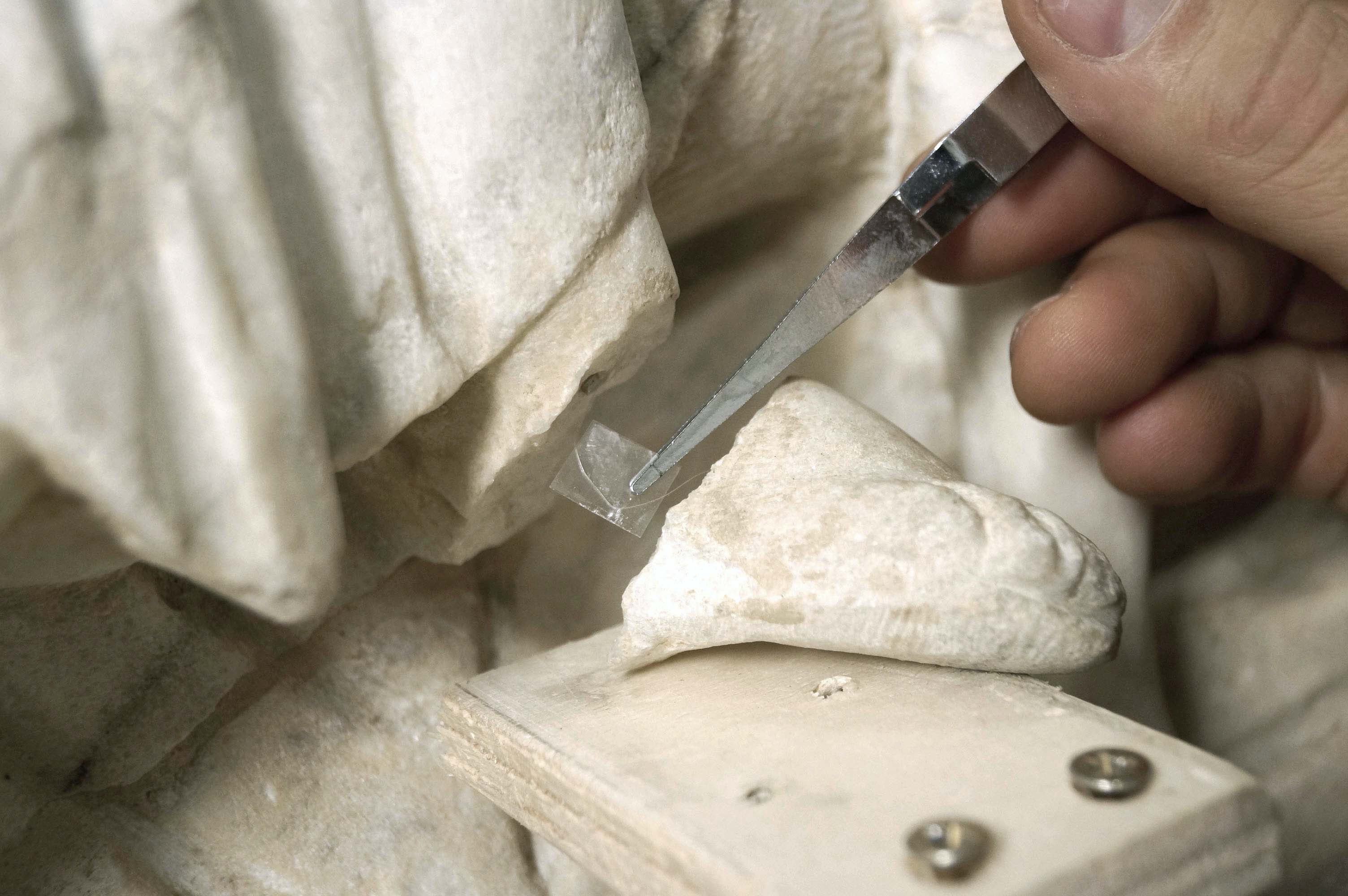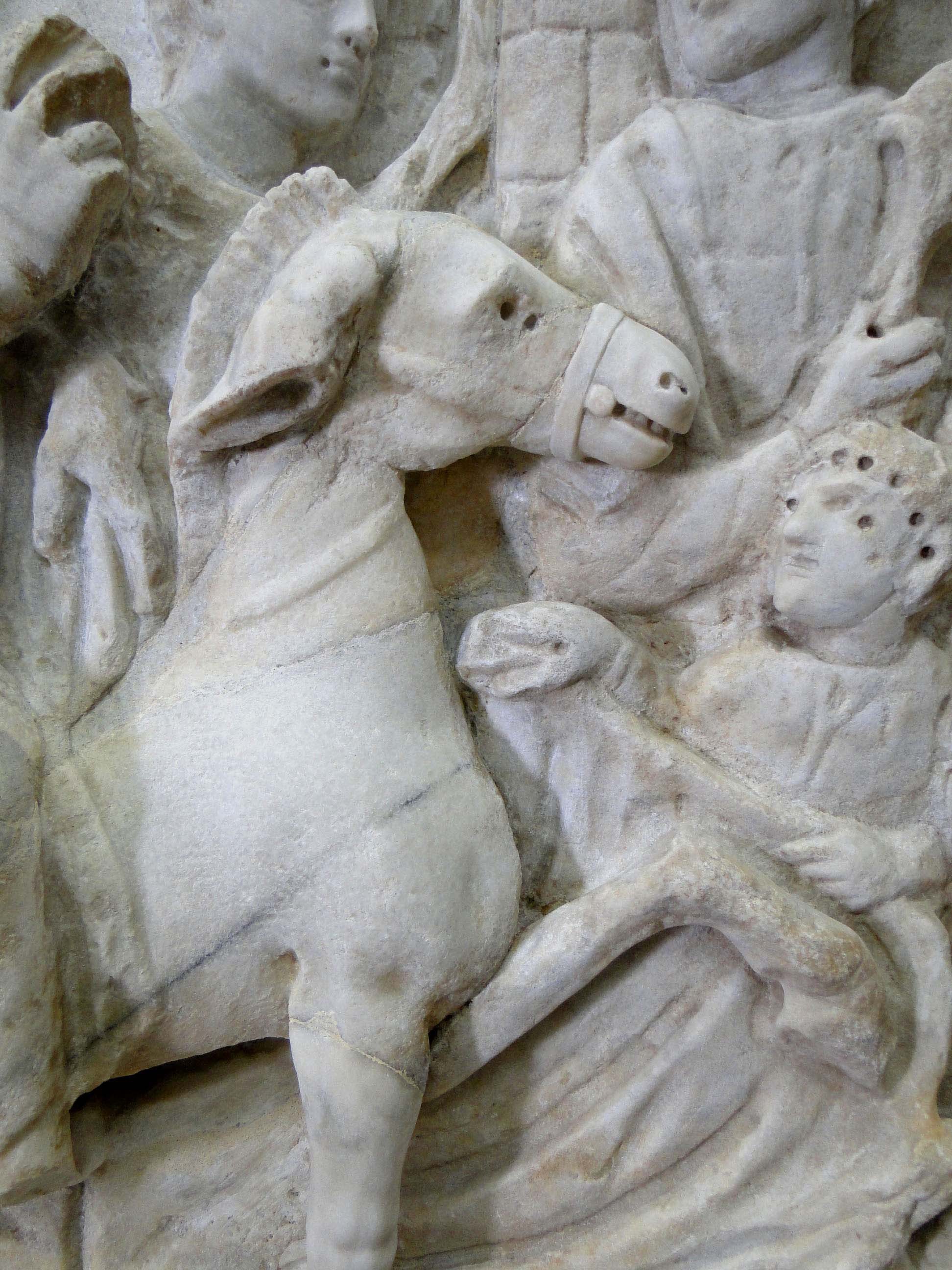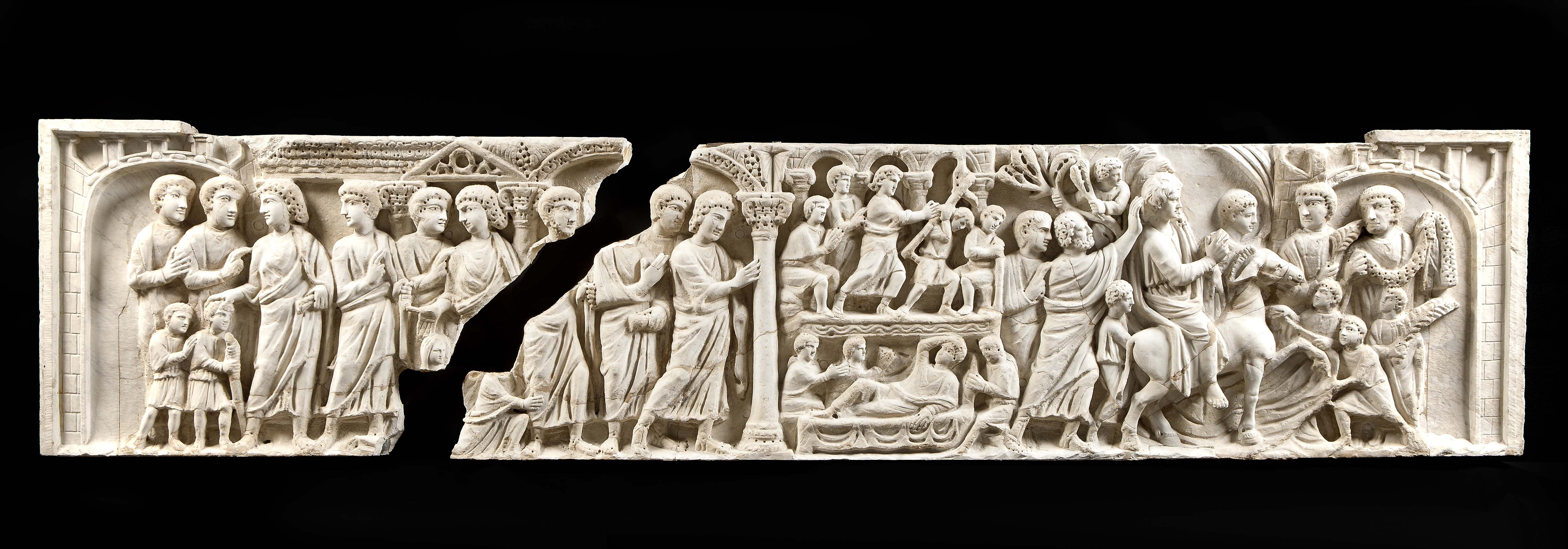Early Christian Sarcophagi: Miracle of Bethesda
Artist: Unknown
Date: 375-400 AD
Classification: Sarcophagus
Dimensions: 58 x 228 x 9 cm
Materials: Marble
Total Cost: € 10,700
Description
This wonderful front of sarcophagus dates back to 375-400. It represents the healing of the paralytic at the pool of Bethesda : one of the miracles of Jesus set at the pool in Jerusalem and described exclusively by the Gospel of John (5,1-18). It is depicted on this sarcophagus with Jesus accompanied by two apostles and the paralytic who lies beneath a stylized pool with the image of the miracle above. Accompanying this rendering are various scenes, most of which are healing miracles of Jesus: the Healing of two blind men (Matthew 9,27-31); the healing of the woman suffering from hemorrhages (Mark 5:25-34) and Jesus’ entry into Jerusalem (Mark 11,1-11). The healing miracles emphasize Jesus’ divinity as well as his acts of love and mercy. They highlight the compassion of Jesus for the suffering of humanity.
Restoration Procedures
The delicate work of cleaning has taken into account the complexity of the original surfaces, which still retain traces of old polychrome, in combination with the additions and coatings applied during the restoration performed in 1757 by the renowned restorer and sculptor, Bartolomeo Cavaceppi. Thus, the Diagnostics Laboratory of the Vatican Museums has carried out an in-depth analytical campaign in preparation for the restoration in order to better understand and determine the appropriate technique to apply and the conservation which follows.
The front of sarcophagus is composed by two large, fractured portions, that had been reassembled in recent years by means of polyester resin gluing, which has currently been removed.
In order to assemble the front of the sarcophagus without resorting to invasive techniques, the team decided to perform a scan of the back side and edges of the piece with the aid of structured 3D lighting. Thanks to this technique, was completed a shell made of carbon fiber. This structure will be anchored to the existing holes on the back and along the edges of the perimeter, ensuring the seal and reverse intervention. The bonding operation of the fracture required the use of reversible adhesives.
During the restoration, the sarcophagus also underwent an assembly method, devised by Stefano Spada of the Marble Restoration Lab, which was performed with magnets and reversible adhesive. This methodology has been applied for the re-adhesion of an insert made by Cavaceppi and specifically the foot of Christ in the scene of the Entrance into Jerusalem, which had already been detached and reassembled with a polyester resin.
Detail
Patrons:
William & Susan Coleman
Inventory N°: 31461
Artist: Unknown
Date: 375-400 AD
Dimensions: 58 x 228 x 9 cm
Materials: Marble
Department:
Christian AntiquitiesCurators:
Dr. Umberto Utromuseum:
Pius-Christian MuseumLaboratories:
Stone MaterialsWishbook year: 2014
Total Cost
€ 10,700

Early Christian Sarcophagi: Miracle of Bethesda

Details
Patrons: William & Susan Coleman
Inventory: 31461
Artist: Unknown
Date: 375-400 AD
Classification: Sarcophagus
Materials: Marble
Dimensions: 58 x 228 x 9 cm
Museum: Pius-Christian Museum
Department: Christian Antiquities
Laboratory: Stone Materials
Wishbook year: 2014
Description
This wonderful front of sarcophagus dates back to 375-400. It represents the healing of the paralytic at the pool of Bethesda : one of the miracles of Jesus set at the pool in Jerusalem and described exclusively by the Gospel of John (5,1-18). It is depicted on this sarcophagus with Jesus accompanied by two apostles and the paralytic who lies beneath a stylized pool with the image of the miracle above. Accompanying this rendering are various scenes, most of which are healing miracles of Jesus: the Healing of two blind men (Matthew 9,27-31); the healing of the woman suffering from hemorrhages (Mark 5:25-34) and Jesus’ entry into Jerusalem (Mark 11,1-11). The healing miracles emphasize Jesus’ divinity as well as his acts of love and mercy. They highlight the compassion of Jesus for the suffering of humanity.
Restoration Procedures
The delicate work of cleaning has taken into account the complexity of the original surfaces, which still retain traces of old polychrome, in combination with the additions and coatings applied during the restoration performed in 1757 by the renowned restorer and sculptor, Bartolomeo Cavaceppi. Thus, the Diagnostics Laboratory of the Vatican Museums has carried out an in-depth analytical campaign in preparation for the restoration in order to better understand and determine the appropriate technique to apply and the conservation which follows.
The front of sarcophagus is composed by two large, fractured portions, that had been reassembled in recent years by means of polyester resin gluing, which has currently been removed.
In order to assemble the front of the sarcophagus without resorting to invasive techniques, the team decided to perform a scan of the back side and edges of the piece with the aid of structured 3D lighting. Thanks to this technique, was completed a shell made of carbon fiber. This structure will be anchored to the existing holes on the back and along the edges of the perimeter, ensuring the seal and reverse intervention. The bonding operation of the fracture required the use of reversible adhesives.
During the restoration, the sarcophagus also underwent an assembly method, devised by Stefano Spada of the Marble Restoration Lab, which was performed with magnets and reversible adhesive. This methodology has been applied for the re-adhesion of an insert made by Cavaceppi and specifically the foot of Christ in the scene of the Entrance into Jerusalem, which had already been detached and reassembled with a polyester resin.
Media

Early Christian Sarcophagi: Miracle of Bethesda - Before Restoration

Early Christian Sarcophagi: Miracle of Bethesda - After Restoration

Early Christian Sarcophagi: Miracle of Bethesda - During Restoration

Early Christian Sarcophagi: Miracle of Bethesda - Detail After Restoration

Early Christian Sarcophagi: Miracle of Bethesda full vision

© 2025 Patrons of the Arts
in the Vatican Museums
Vatican Museums V-00120,
Vatican City State (Europe)
+39 0669864499
